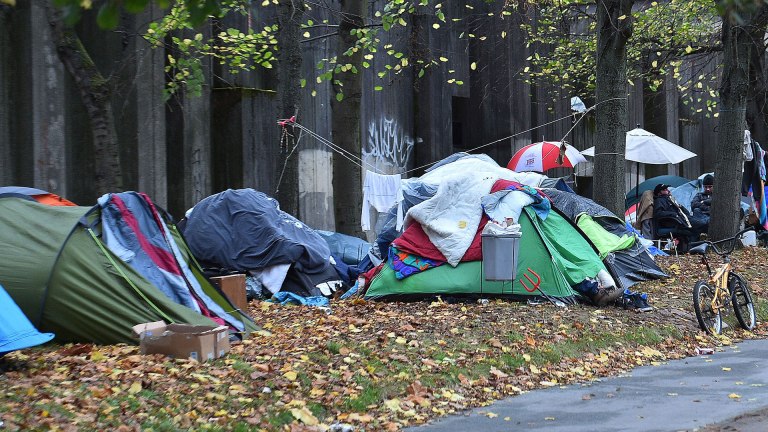“That’s about homeowners in certain areas feeling resentful that they are in places that don’t seem to matter, that have been, to coin a phrase, ‘left behind’. What better represents how much society values places than the price it attaches to living there?
“That’s the old story and it’s probably still true to some degree. It helps explain why Trump has done well in places like Ohio or upstate New York.”
House prices recorded by the Federal Housing Finance Agency (FDFA) found selling prices were almost 58% higher on average in July 2024 compared to the same month in 2019. Meanwhile, consumer price index inflation shows prices rose 22% over the space of those five years.
Meanwhile, rising mortgage rates disproportionately impacted people who were trying to get on the housing ladder. Nearly all 50 million active mortgages in the US are on fixed rates below the current market rate, according to the FDFA, with 30-year mortgages the norm.
Rising interest rates led to a 57% reduction in home sales and prevented 1.3 million sales in 2022-23 and saw home prices up 5.7% as a result.
It mattered to voters too. A Pew Research Center survey held in September ahead of the 5 November election, found 69% of Americans said they were “very concerned” about the cost of housing. Just over a year earlier that figure was 61%.
Advertising helps fund Big Issue’s mission to end poverty
Both Donald Trump and Democrat rival Kamala Harris took different approaches to the housing crisis on the campaign trail.
Harris pledged to build three million new homes in her first term if she had been elected, offered tax incentives to builders a $40bn and a $25,000 down payment to help first-time buyers.
But some critics asked why Harris had not been able to build enough homes while serving as Biden’s vice-president as the Democrats struggled to convince Congress to invest big.
Trump was all too eager to pin rising house prices on immigration. He told an Arizona rally in September that immigration is “driving housing costs through the roof” and pledged to “make housing affordable again”.
Reducing inflation and illegal immigration would bring down costs, Trump said, alongside plans to cut housebuilding red tape.
Ansell said renters are also feeling the pinch and this, too, had an impact on support for parties.
Advertising helps fund Big Issue’s mission to end poverty
Over 21 million renter households spend more than 30% of their income on housing costs, according to the US Census Bureau.
Paying out more than 30% of income on housing is largely considered to be unaffordable. Black or African American households were most likely to be above that threshold, accounting for 4.6 million or 56.2% of renting households from that race group.
“My colleague Tarik Abou-Chadi’s argument is that where rents have been going up really fast that also pushes people away from mainstream parties,” added Ansell.
“I think you see a bit of that in what we can tell so far from the US presidential election. If you look at New York City, Harris did relatively poorly in a number of the poorer ethnic minority populated districts in Queens and in the Bronx but she did really well in the Upper East Side and Brooklyn.
“Inflation and higher interest rates has meant rising rents all across America. And I think you can see in places like New York and even in Philadelphia that there in the somewhat poorer neighbourhoods where the rents have been rising rapidly and where people don’t have a lot of disposable income, that’s where Harris lost a lot of steam.
“I think rising rents have led to a backlash against whoever is in power, but also against the feeling that Democrats don’t really care about it. Maybe Donald Trump does, maybe he doesn’t, but it’s held the door open for him.”
Advertising helps fund Big Issue’s mission to end poverty
But not all parts of the country are experiencing a housing crisis in the same way.
Ansell said political scientists are considering whether many of the more rural states that voted Republican are feeling the same pressures as metropolitan centres that traditionally back the Democrats.
“One thing we’re thinking about is that the housing crisis is much less of a crisis in the red Republican states,” he said.
“There’s been some argument there that, in the Democratic-leaning states, it is still hard to build housing. Planning laws are really tough in California, New York, Massachusetts and so on so prices have remained very high.
“The Republican states there’s basically substantially less planning regulation and there’s less of a problem. That has arguably pushed some younger voters towards the Republican Party.
“The housing crisis is still probably with us in the big cities but in other parts of the country, maybe less so, and I think that’s to the degree that people associate being able to afford a house with the Republicans or Donald Trump.”
Advertising helps fund Big Issue’s mission to end poverty
The US election is far from on its own in being impacted by house prices – they have also played a role in UK votes.
Ansell said inflation and the cost of living have had a bigger impact on the political landscape in 2024 than it has for decades.
But that’s because inflation has generally been low in the UK over that period, except for housing.
Halifax announced a new record average house price of £293,999 just last week while average UK rents increased by 8.4% in the 12 months to September 2024, far in excess of wider inflation at 2.6% factoring in housing costs.
Homeownership reared its head in pre-election debates between Keir Starmer and Sunak as did the plight of renters after the Tories failed to deliver on its manifesto promise to reform the private rental sector.
But expect volatility in elections to come if Labour can’t get to grips with the housing crisis, delivering 1.5 million homes and a Renters’ Rights Bill while in charge.
Advertising helps fund Big Issue’s mission to end poverty
“It stored up all kinds of problems among younger people, especially in the UK,” said Ansell.
“We’ve seen in the election that actually people really care about inflation but maybe we should remind ourselves that there’s a reason why younger people were getting increasingly more and more irate over the last 20 years.”
Do you have a story to tell or opinions to share about this? Get in touch and tell us more. This Christmas, you can make a lasting change on a vendor’s life. Buy a magazine from your local vendor in the street every week. If you can’t reach them, buy a Vendor Support Kit.









